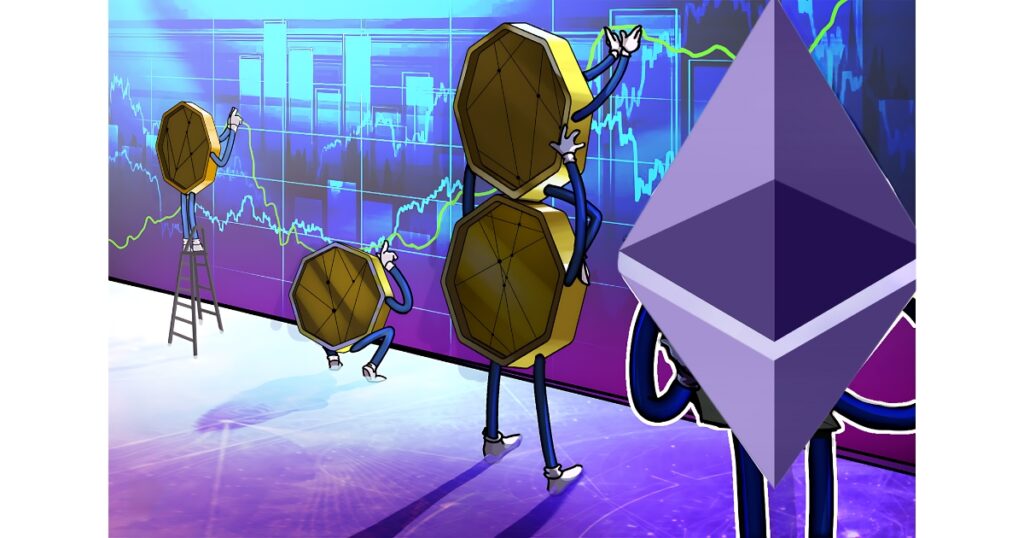The price of ether is still falling as uneasy investors fret about dwindling Ethereum network fees, a possible busted tech stock bubble, and a shortage of spot ether inflows.
After a significant denial at the $2,550 resistance, Ether ETH’s price of $2,389 fell 5.2% between September 3 and September 4, representing eight days from when it last closed over that level.
With fixed income incentives projected to decline in the US, traders are now worried that Ether might struggle even if the overall crypto bull market continues. What, then, is exerting pressure on the price of ether?
If the bubble in tech stocks bursts, will Ether fall?
While some industry players might blame conventional financial market conditions for the underwhelming performance of cryptocurrencies, Ether is also dealing with a number of issues of its own, such as reduced network fees, unattractive staking rewards, and low demand for its recently introduced spot exchange-traded fund (ETF) products. Consequently, it’s worthwhile to investigate if these elements will keep pushing Ether’s price lower in the future.
Macroeconomically speaking, it is unclear how the United States Federal Reserve will proceed with its anticipated decision to lower rates of interest, which is anticipated to start in September. According to Yahoo Finance, former president of the Kansas City Fed Esther George stated that although 2% inflation is still conceivable, the Fed’s legitimacy may be called into doubt if the labor market continues to deteriorate.
Furthermore, Philadelphia Fed President Patrick Harker said that should the job market worsen, the Fed may pursue more aggressive interest rate reductions. The demand for safe-haven assets rises when investors believe a recession is coming, which leads traders to seek refuge in safer investments and might have a negative impact on Ether’s price. Normally, an expansionary monetary policy supports riskier markets.

Particularly after Nvidia shares shed a record $279 billion in market capitalization on September 3, traders are extremely anxious about the tech sector. The chipmaker had a three-day decrease of 14% in response to two pessimistic research reports about the artificial intelligence industry’s prospects. In addition, on November 3, Nvidia received a subpoena as a part of an antitrust probe by the US Department of Justice.
Ether’s possible underperformance in comparison to the larger cryptocurrency market, however, may be justified by a number of distinctive features. For instance, diminished activity on Ethereum’s foundation layer has resulted in decreased fees, endangering the network’s long-term viability. While some could contend that this is a reflection of layer-2 solutions for scaling being successfully adopted, there is still an issue with regard to of long-term motivations.
Ethereum network fees reached $3.1 million in the week ending August 31, which was the lowest amount in more than four years, according to DefiLlama. The 88% decrease in just four weeks has prompted criticism of Ethereum’s pay structure. One such criticism, made on AbstractChain by contributor Cygaar, attributes this decline to the “essentially free” price of availability of data for rollups.
Because there aren’t many compelling consumer-facing apps that could contribute to the restoration of a stable level of fees, Cygaar also draws attention to the comparatively lack of demand for layer-2 solutions. The analyst wonders if gas prices would be required for long-term network safety and if researchers misjudged the demand for rollups.
Ethereum network costs are declining, and poor spot movements of Ether ETFs

In addition to the drop in network fees, Ether is having trouble with its spot ETF services, as evidenced by the $47 million in net withdrawals that occurred on September 3 alone. Since they were introduced to the US market on July 23, these instruments have actually seen withdrawals totaling $475 million. The absence of investor interest is worrisome, given that institutional demand was thought to be a major selling point for Ether.
The very low 3.2% staking yield, especially considering the present 0.7% annual rate of inflation, is another aspect that has contributed to Ether’s price fall, according to StakingRewards. Since the yield is less than that of the majority of US government bonds, investors may have been let down by the story of “ultrasound money” that some experts tried to sell them.
In the end, there’s little sign that the elements influencing Ether’s price, like dropping network fees and a lackluster market for its spot ETF products, will suddenly turn around. Ether’s price may not stay below $2,550, but this indicates that it is uncertain to outperform the larger cryptocurrency market in the foreseeable future.
A trader uses Ethereum Pump to turn $5,000 into $670K.competitor for enjoyment Ethervista

For a brief period, the native VISTA token of the system surged to a value of up to $30 million, making a sizable profit for one trader.
Purchasing the native token of Ethervista, a brand-new Ethereum decentralized exchange (DEX) and token making marketplace, has allowed a cryptocurrency trader to lock in enormous profits.
Shortly after the Ethervista protocol launch, the trader bought $5,000 worth of Ethervista (VISTA) tokens. With this acquisition, they acquired about 5% of the VISTA tokens that are now in circulation. The tokens were made available for trading on August 31.
Based on a Sept. 3 X tweet from crypto intelligence site Arkham, the dealer then divided his VISTA holdings among seven separate wallets to sell it out, generating nearly $670,000 in gain in Ether ETH $2,396 in just two days.
Ethervista is a brand-new Ethereum-based token minting platform that lets users design and release their own tokens, mostly memecoins.
Ethereum’s “response” to Pump.fun – Ethervista
Some analysts of the cryptocurrency space have referred to Ethervista as “Ethereum’s answer” to its rival Pump.fun, a memecoin launchpad located in Solana that has seen astronomical growth since its release in January.
In order to prevent early rug pulls, 100% of the native VISTA tokens on the retro-themed Ethervista platform were distributed to liquidity providers and frozen for a five-day period.
With a cap of one million tokens and ongoing token burning to lower supply and increase the price floor, it features deflationary tokenomics.
Some have, nevertheless, reported unsuccessful attempts to withdraw liquidity.
While acknowledging the liquidity lock, cryptocurrency expert Stacy Muur stated that “it’s the ETH/USDT pair, not the recently developed currency that requires anti-rug security,” and that customers were not informed via a disclaimer.

Ethervista collects fees in native Ethereum, which are split amongst liquidity suppliers and token producers, in contrast to conventional DEXs and marketplaces.
With 22.5 ETH, the platform is now the third-largest gas user behind Uniswap and Tether above the last 24 hours, according to Etherscan, as a result of its increased gas demand since it started using ETH for network fees.
As shown by DEX Screener data, the native token’s market valuation reached as much as $30 million within two days after it began, demonstrating the enormous interest that participants
As of this writing, the price of VISTA has increased 33% in the last day, hitting $21.19, according to CoinGecko. Only a few days after its launch, on September 2, the new coin reached its peak price of $28.80. The liquidity release on September 4th, nevertheless, might lead to volatility.




 Bitcoin
Bitcoin  Ethereum
Ethereum  Tether
Tether  Solana
Solana  USDC
USDC  Lido Staked Ether
Lido Staked Ether  XRP
XRP  Toncoin
Toncoin  Dogecoin
Dogecoin  Cardano
Cardano  TRON
TRON  Shiba Inu
Shiba Inu  Avalanche
Avalanche  Wrapped Bitcoin
Wrapped Bitcoin  Polkadot
Polkadot  Chainlink
Chainlink  Bitcoin Cash
Bitcoin Cash  Uniswap
Uniswap  NEAR Protocol
NEAR Protocol  LEO Token
LEO Token  Dai
Dai  Litecoin
Litecoin  Polygon
Polygon  Wrapped eETH
Wrapped eETH  Internet Computer
Internet Computer  Pepe
Pepe  Ethena USDe
Ethena USDe  Ethereum Classic
Ethereum Classic  Artificial Superintelligence Alliance
Artificial Superintelligence Alliance  Aptos
Aptos  Stellar
Stellar  Monero
Monero  Maker
Maker  Hedera
Hedera  Stacks
Stacks  Cronos
Cronos  Render
Render  Filecoin
Filecoin  Cosmos Hub
Cosmos Hub  OKB
OKB  Mantle
Mantle  Arbitrum
Arbitrum  Renzo Restaked ETH
Renzo Restaked ETH  Immutable
Immutable  Sui
Sui  Injective
Injective  Optimism
Optimism
Your blog is a true hidden gem on the internet. Your thoughtful analysis and in-depth commentary set you apart from the crowd. Keep up the excellent work!
of course like your website but you have to check the spelling on several of your posts A number of them are rife with spelling issues and I in finding it very troublesome to inform the reality on the other hand I will certainly come back again
I’ve been following your blog for some time now, and I’m consistently blown away by the quality of your content. Your ability to tackle complex topics with ease is truly admirable.